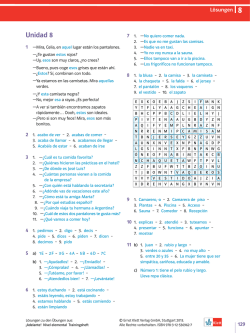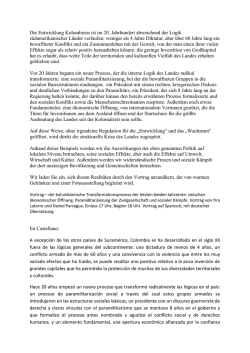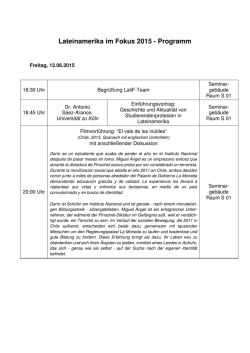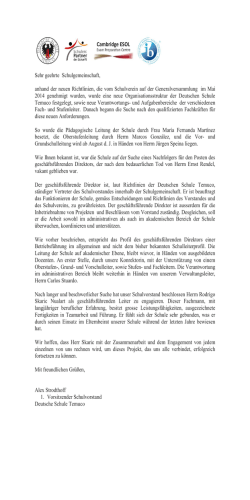
robustness of flat slab structures subjected to a - ETH E
Dissertation ETH No. 23524 ROBUSTNESS OF FLAT SLAB STRUCTURES SUBJECTED TO A SUDDEN COLUMN FAILURE SCENARIO A dissertation submitted to ETH ZURICH to attain the degree of DOCTOR OF SCIENCES (Dr. sc. ETH Zurich) presented by BORJA HERRAIZ GÓMEZ Ingeniero de Caminos, Canales y Puertos, Technical University of Madrid born 18th March 1987 citizen of Spain accepted on the recommendation of Prof. Thomas Vogel (ETH Zurich, Examiner) Prof. Dr. Robby Caspeele (Ghent University, Co-examiner) 2016 ABSTRACT Several catastrophic building collapses during the last decades have emphasised the necessity for increasing the progressive collapse resistance of structures. In response, several widely used design codes have included the requirement that a structure should be capable of surviving the removal of a load-bearing element. This approach, often referred to as the sudden column removal scenario, is hazard-independent and focuses solely on the capacity of a structure to utilise alternative load paths and redistribute gravity loads after the loss of a column. The behaviour of steel and reinforced concrete frame structures subjected to this hazard scenario has been the topic of extensive research, and design requirements have been proposed. Such investigations for reinforced concrete flat slabs, however, are much scarcer. It is important to consider the behaviour of such slabs in more detail since they are commonly used in buildings where large agglomerations of human beings occur. This is primarily due to the benefits of their design flexibility and low construction height. The analysis of flat slab structures subjected to a sudden column removal scenario is a challenging task due to the large resulting deformations, and simplified structural models need to be developed. This research project focuses on the response of flat slab structures to a sudden column loss and proposes a global procedure to evaluate and quantify the robustness of such structures subjected to this hazard scenario. This procedure addresses the indirect issues related to the idealisations of the structural system modelling, the corresponding boundary conditions, the critical failure modes and the extent of damage in flat slab buildings subjected to a column removal. Direct problems arising from the analysis of the bay directly affected by the sudden column loss, such as material and geometrical nonlinearities and dynamic effects, were investigated in detail. In addition, an indicator is proposed to quantify the structural robustness of flat slab structures. The dynamic component of this problem was simplified through the implementation of an energybased method, which reduces the analysis of the system to that of a push-over static response. This approach is based on several simplifications, which lead to approximate, yet accurate values of the maximum dynamic response of the structural system. A parameter study was performed to investigate the sensitivity of this method to different variables, and results from the method were compared to experimental results. The analyses indicate that this approach consistently leads to moderately conservative predictions for typical slab configurations. Additional experimental results are required, however, to validate the accuracy of the proposed method. The calculation of the push-over static response requires consideration of the influence from material and geometrical nonlinearities. In order to solve this problem, a new approach was developed to estimate the static response of laterally unrestrained reinforced concrete slabs considering membrane action. This method is based on the kinematics of a rigid perfectly-plastic slab model and equilibrium of the internal forces originating from the corresponding deformations. Typical failure criteria were implemented to estimate the load-bearing capacity and corresponding failure deflection. Response predictions from the developed method were compared to experimental results from a set of 45 specimens, originating from different experimental campaigns, and simulations utilising other approaches. A comparative assessment suggests that the proposed method generally leads to more precise, accurate, and therefore reliable predictions than the other approaches considered. The errors and deviations of the results obtained with this method are small, and the proposed method represents a promising new alternative to more complex and time-consuming numerically-based, approaches without losing significant accuracy. In addition, it was found that the decrease on load-bearing capacity due to dynamic effects after the sudden column loss was practically balanced by a corresponding increase of the bearing capacity due to membrane action for most of the considered specimens. Therefore, it would be possible to neglect both these effects in future calculations without incurring unacceptably large errors. xxiii Abstract In conclusion, the proposed global procedure enables performing accurate, quick, homogeneous and simple robustness assessments for flat slab structures subjected to a sudden column removal scenario. This procedure can also easily be extended in order to consider different dynamic effects, boundary conditions, failure modes, structural configurations and materials. xxiv KURZFASSUNG In den letzten Jahrzehnten haben mehrere katastrophale Gebäudeeinstürze schmerzlich aufgezeigt, dass Tragwerke hinsichtlich eines progressiven Kollapses nicht ausreichend dimensioniert werden. Als Folge wurden in mehreren weitverbreiteten Normen die Konstruktionsanforderungen insofern angepasst, dass Tragwerke den Ausfall eines einzelnen Tragelements überstehen sollen. Dieser Ansatz, der oft als Gefährdungsbild plötzlicher Stützenausfall bezeichnet wird, ist gefahrenunabhängig und basiert auf der Fähigkeit von Tragwerken alternative Lastpfade zu schaffen und dadurch die bestehenden Lasten nach einem Ausfall umzuverteilen. Ausführliche Forschungsvorhaben über das Verhalten von Rahmenkonstruktionen aus Stahl und Stahlbeton infolge plötzlicher Stützenausfall wurden durchgeführt und darauf basierend Konstruktionsanforderungen vorgeschlagen. Untersuchungen an Stahlbetonflachdecken sind deutlich seltener. Flachdecken werden jedoch gerne auch in Gebäuden mit grossen Menschenansammlungen genutzt, da sie flexibel einsetzbar sind und eine relativ niedrige Konstruktionshöhe haben. Daher ist es wichtig, ihr Verhalten beim Gefährdungsbild plötzlicher Stützenausfall im Detail zu betrachten. Eine Analyse ist infolge der zu erwartenden grossen Verformungen schwierig, und daher sind vereinfachte Tragwerksmodelle erforderlich. Das vorliegende Forschungsprojekt konzentriert sich auf das Verhalten von Flachdecken infolge eines plötzlichen Stützenausfalls und stellt ein globales Vorgehen vor, um die Robustheit solcher Tragwerke zu beurteilen. Das vorgeschlagene Vorgehen befasst sich mit den indirekten Problemen bezüglich der Idealisierung des Tragwerks, den entsprechenden Randbedingungen, des kritischen Ausfallmodus und der Schadstelle in der Flachdecke. Die direkten Probleme wie nichtlineares Materialverhalten, geometrische Nichtlinearitäten und dynamische Einwirkungen, die aus der Analyse der direkt betroffenen Flachdecke entstehen, werden im Detail untersucht. Zudem wird ein Faktor vorgeschlagen, um die Robustheit von Flachdeckenkonstruktionen zu bewerten. Um die dynamische Komponente des Problems zu vereinfachen, wurde eine Energiebilanzmethode entwickelt. Dieser Ansatz erlaubt es, die dynamische Komponente durch das statische Tragverhalten des Systems zu bestimmen. Durch die vorausgesetzten Annahmen können damit die tatsächlichen Werte der maximalen Verschiebungen des Systems approximiert werden. Zur Verifikation der Methode wurde einerseits eine Parameterstudie durchgeführt und andererseits die bestimmten Werte mit Ergebnissen von experimentellen Versuchen verglichen. Die Ergebnisse dieser Untersuchungen zeigen, dass für typische Flachdecken der gewählte Ansatz stets zu leicht konservativen Prognosen führt. Die Ergebnisse sind allerdings nicht eindeutig hinsichtlich der Genauigkeit des Verfahrens. Daher sind weitere experimentelle Ergebnisse wünschenswert, um die Methode zu validieren. Um die Berechnung des statischen Tragverhaltens des Systems durchzuführen, müssen sowohl das nichtlineare Materialverhalten sowie die geometrischen Nichtlinearitäten berücksichtigen werden. Dazu wurde eine neue Methode entwickelt, um das statische Tragverhalten von seitlich nicht gehaltenen Stahlbetonplatten unter Berücksichtigung der Membranwirkung abzuschätzen. Dieses Verfahren beruht auf der Kinematik einer perfekt starr plastischen Platte und dem Gleichgewicht der inneren Kräfte. Realistische Ausfallkriterien wurden angenommen, um die Tragfähigkeit und die auftretenden Durchbiegungen beim Versagen abzuschätzen. Das neue Verfahren wurde mit den Ergebnissen von 45 verschiedenen experimentellen Versuchen verglichen. Zusätzlich erfolgte ein Vergleich mit Simulationen basierend auf anderen bereits vorhandenen Ansätzen. Die Ergebnisse dieser Analyse deuten darauf hin, dass die hier vorgestellte Methode in der Regel zu präziseren und deshalb verlässlicheren Prognosen führt als die bekannten Ansätze. Die Abweichungen des Verfahrens sind moderat, weshalb es eine viel versprechende Alternative zu komplexen und zeitraufwendigen numerischen Methoden ist, ohne bedeutend an Genauigkeit zu verlieren. Eine weitere Erkenntnis ist, dass die Abnahme der Tragfähigkeit aufgrund der dynamischen Einwirkungen nach einem plötzlichen Stützenausfall durch die Zunahme der Tragfähigkeit aufgrund der Membranwirkung xxv Kurzfassung – für die meisten der untersuchten Exemplaren – praktisch ausgeglichen ist. Deshalb kann ein Ansatz darin liegen, zukünftig beide Effekte bei der Analyse zu vernachlässigen. Das vorgeschlagene einfache globale Vorgehen, um Flachdecken infolge eines plötzlichen Stützenausfalls zu analysieren, ermöglicht die zügige und homogene Durchführung von Robustheitsbeurteilungen. Das vorgeschlagene Vorgehen kann weiter entwickelt werden, um andere Randbedingungen, dynamische Einwirkungen, Ausfallmodi, Tragwerksgestaltungen oder Materialien zu berücksichtigen. xxvi RESUMEN Durante las últimas décadas, diversos edificios han colapsado con consecuencias catastróficas, lo cual ha acentuado la necesidad de incrementar la resistencia estructural frente a colapsos progresivos. Consecuentemente, varias normativas internacionales han incorporado como un requisito para el diseño que las estructuras sean capaces de resistir la pérdida de un elemento portante. Esta estrategia, comúnmente conocida como supresión repentina de una columna, es independiente del efecto o acción que produce este suceso y se centra únicamente en la capacidad de la estructura de establecer rutas alternativas de carga así como redistribuir las cargas gravitatorias tras la supresión de una columna. La respuesta a tal extraordinario suceso de estructuras reticuladas tanto de acero como de hormigón armado, ha sido objeto de amplias investigaciones. Al mismo tiempo, se han propuesto requisitos para el diseño de estas estructuras. Sin embargo, las estructuras formadas por forjados planos de hormigón armado apenas han sido investigadas en este aspecto. Este tipo de configuración estructural, muy popular debido a la flexibilidad que ofrece en la distribución de espacios y a la reducida altura de canto, se utiliza en construcciones donde se producen grandes aglomeraciones, y por ello, resulta necesario estudiar su respuesta estructural en detalle. Las grandes deformaciones a las que se ven sometidos los forjados planos de hormigón a consecuencia de la supresión repentina de una columna, hacen que el análisis estructural sea altamente complejo. Por ello, resulta necesario el uso de modelos simplificados. El presente proyecto de investigación se centra en la respuesta estructural de forjados planos de hormigón armado tras la supresión repentina de una columna, incluyendo un procedimiento para evaluar y cuantificar la robustez de este tipo de estructuras. Este procedimiento se ocupa, por un lado, de los problemas indirectos correspondientes a la idealización estructural y sus condiciones de contorno, las tipologías críticas de colapso y la extensión de los daños tras el suceso. Por otro lado, las cuestiones derivadas del análisis estructural correspondientes al vano directamente afectado por la columna eliminada, tales como las no linealidades en las propiedades de los materiales y en la geometría del sistema así como los efectos dinámicos, han sido investigadas en detalles. Además, este proyecto de investigación incluye un nuevo factor para la evaluación de la robustez estructural de forjados planos. Con el fin de simplificar estos efectos dinámicos, se ha empleado un método basado en el equilibrio de energías. Este método permite calcular la respuesta dinámica a través de la respuesta incremental estática del sistema. Las diferentes simplificaciones y suposiciones que de forma inherente incluye este método, llevan a la predicción de resultados aproximados, pero suficientemente exactos, de la máxima respuesta dinámica. A fin de evaluar la robustez y exactitud de este método, se incluyen un estudio de parámetros de distintas variables y una comparación de las predicciones del método con resultados experimentales. Estos análisis demuestran que este método, para configuraciones estructurales típicas, siempre predice estimaciones que se encuentran moderadamente del lado de la seguridad. Sin embargo, para poder validar completamente la exactitud de este método, se requiere un mayor número de resultados experimentales. El análisis estructural correspondiente a la respuesta incremental estática debe tener en cuenta los efectos de las no linealidades materiales y geométricas. Consecuentemente, un nuevo método ha sido desarrollado para estimar la respuesta incremental estática de losas de hormigón armado sin restricciones laterales considerando los efectos membrana. Este método se basa en la cinemática de un modelo de losa ideal rígidoplástico y en el equilibrio de los esfuerzos originados por las correspondientes deformaciones. Diversos criterios de rotura fueron implementados con el fin de realizar una estimación realista de las capacidades de carga en rotura de la losa y sus correspondientes flechas. Las predicciones de este nuevo método han sido comparadas con los resultados experimentales de un conjunto de 45 muestras de diferentes campañas, incluyendo las predicciones de otros métodos ya existentes. Los resultados de esta comparación sugieren que el nuevo método predice, en general, estimaciones más exactas, precisas, y por lo tanto, más fiables que los otros métodos considerados. Los errores y desviaciones derivados de los resultados de este método son xxvii Resumen pequeños y podría proponerse como una alternativa real a otros complejos y tediosos métodos numéricos, sin por ello perder demasiada exactitud. Adicionalmente, esta investigación sugiere que, para la mayoría de las losas estudiadas, la disminución de la capacidad de carga debido a los efectos dinámicos se contrarresta prácticamente con el aumento de la capacidad de carga debido al efecto membrana. Resultaría, por consiguiente, posible ignorar estos efectos en futuros análisis sin por ello dar lugar a errores excesivos. En conclusión, el procedimiento global propuesto permite la realización de evaluaciones exactas, rápidas, homogéneas y simples de la robustez estructural de forjados planos de hormigón armado sometidos a la supresión repentina de una columna. Este procedimiento puede seguir desarrollándose fácilmente con el fin de incorporar otras tipologías estructurales, condiciones de contorno, efectos dinámicos, tipologías críticas de colapso y materiales estructurales. xxviii
© Copyright 2025









